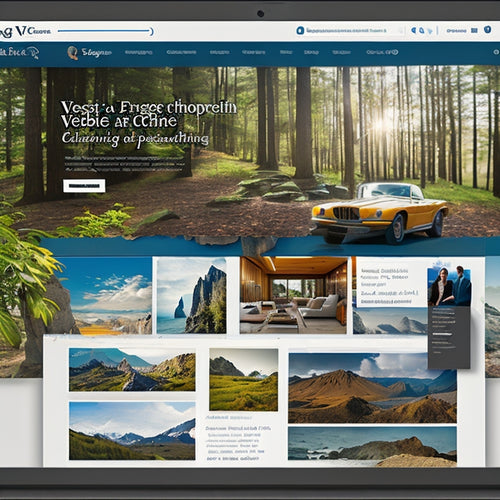
Roadmap to Online Course Success: A Strategic Guide
Share
You're about to create an online course, but you know that simply putting content online isn't enough to guarantee success. To set yourself up for success, start by defining your target audience and their needs. Next, choose a platform that fits your features and scalability requirements. Develop engaging content that tells a story and includes interactive elements, and set clear learning objectives for structured courses. Design a user-friendly interface that's accessible and engaging. Establish feedback mechanisms, optimize for mobile devices, and monitor performance metrics. By following these strategic steps, you'll be well on your way to creating a successful online course that truly delivers - and there's even more to explore ahead.
Key Takeaways
• Identify your target audience's characteristics and needs to create a tailored online course that meets their expectations.
• Develop engaging content using storytelling, interactive elements, and clear learning objectives to enhance learner engagement.
• Utilize a mix of marketing strategies, including social media advertising, email campaigns, and influencer partnerships to drive enrollments.
• Establish feedback mechanisms to analyze learner feedback, optimize courses, and refine content for better accessibility and engagement.
• Continuously monitor and analyze key metrics to improve course performance, refine content, and enhance overall learning outcomes.
Define Your Target Audience
To create an online course that truly resonates with students, you need to identify and understand your ideal learner, the person who'll be most impacted by your content. This involves conducting an audience analysis to gather insights about your target audience's needs, preferences, and pain points. By doing so, you'll be able to craft a course that addresses their specific challenges and provides valuable solutions.
Demographic targeting is a pivotal aspect of this process, as it helps you pinpoint the age, gender, occupation, and other characteristics of your ideal learner. This information enables you to tailor your course's tone, language, and content to resonate with your audience.
Choose the Right Platform
When selecting a platform for your online course, you'll want to carefully consider the features that matter most to you and your students.
You'll also need to think about the cost and scalability of the platform, as these factors can greatly impact your course's success.
Platform Features Matter
What makes a particular online course platform stand out from the rest, and how can you harness its features to maximize your course's potential?
When selecting a platform, you need to ponder the features that will make your course stand out. Seek customization options that enable you to tailor the platform to your brand and course style. Engagement features like discussion forums, live sessions, and gamification will maintain your students' motivation and involvement. A smooth user experience is also essential, so make sure the platform is user-friendly and easy to navigate.
Additionally, you need to monitor your course's performance, which is where data analytics play a role. A platform that offers comprehensive analytics will assist you in pinpointing areas for enhancement, tracking student progress, and refining your teaching approach. By utilizing these features, you'll be able to develop a course that connects with your students, boosts engagement, and ultimately delivers results.
Don't settle for a platform that lacks the features you need to thrive. Take the time to research and select a platform that will aid you in reaching your objectives.
Cost and Scalability
You'll need to balance the costs of your online course platform with its ability to scale as your student base grows, making sure that your chosen platform won't break the bank or limit your course's potential.
As you weigh your options, consider the following key factors:
-
Cost efficiency: Look for a platform that offers flexible pricing plans that adapt to your growing student base, without sacrificing essential features. You want to make certain that your platform investment yields a high return, without draining your resources.
-
Scalability planning: Your platform should be able to handle sudden surges in enrollment, without compromising performance or user experience. Consider a platform that offers automatic scaling, load balancing, and robust infrastructure to support your growth strategies.
-
Budgeting for growth: Plan your budget according to your growth projections, and choose a platform that aligns with your financial goals. Consider the total cost of ownership, including any additional fees for support, maintenance, or integrations.
Develop Engaging Content
Now that you've chosen the right platform, it's time to focus on creating content that truly resonates with your students.
To do this, you'll need to craft compelling lessons that capture their attention and design interactive activities that keep them engaged.
Craft Compelling Lessons
To captivate your students from the get-go, craft lessons that ignite curiosity, foster emotional connections, and make complex concepts feel invigoratingly accessible. Effective lesson planning is key to achieving this. You want to create an environment where students feel motivated to learn and are excited to dive deeper into the subject matter.
To craft compelling lessons, consider the following strategies:
-
Make it relatable: Use real-life examples or scenarios that resonate with your students' interests and experiences. This helps them see the value and relevance of what they're learning.
-
Use storytelling techniques: Share personal anecdotes, case studies, or historical events that illustrate key concepts and make them more memorable.
-
Incorporate multimedia elements: Incorporate videos, images, or interactive simulations to break up text-heavy content and engage students on different levels.
Design Interactive Activities
As you shift your focus from crafting compelling lessons to designing interactive activities, remember that engaging content is key to keeping students invested in their learning journey.
To achieve this, you'll need to incorporate activities that encourage participation, foster collaboration, and make learning fun.
Gamification techniques, such as point systems, badges, and leaderboards, can be an effective way to motivate students and create a sense of friendly competition.
Another approach is to design collaborative projects that require students to work together to achieve a common goal. This not only promotes teamwork and communication but also helps to build a sense of community within the course.
When designing interactive activities, consider the learning objectives and outcomes you want to achieve, and choose activities that align with these goals. By doing so, you'll create an engaging and effective learning experience that sets your students up for success.
Set Clear Learning Objectives
You'll greatly enhance your online course's effectiveness by establishing clear learning objectives that define what students will achieve by the end of the course. This is pivotal because it sets the tone for the entire learning experience and helps you create a focused, goal-oriented course structure.
By setting clear objectives, you'll be able to:
- Develop effective assessment strategies that measure student progress and understanding
- Increase student engagement through targeted learning activities that align with the objectives
- Implement performance evaluation and feedback mechanisms that provide students with actionable insights for improvement
Clear learning objectives also enable you to design a more intentional and cohesive course experience. You'll be able to create learning materials, activities, and assessments that are all aligned with the desired outcomes, ensuring that students stay on track and achieve the desired results.
Design User-Friendly Interface
A well-designed interface is vital to your online course's success, and a staggering 75% of students cite user experience as a key factor in their overall satisfaction. You can't afford to neglect this critical aspect of your course.
To get it right, prioritize accessibility considerations from the outset. Guarantee that your course is usable by everyone, regardless of abilities or devices. Visual design elements like color schemes, typography, and imagery should be thoughtfully chosen to create an engaging and cohesive learning environment.
But it's not just about looks – you need to guarantee seamless navigation flow. Organize your content in a logical and intuitive manner, making it easy for students to find what they need.
Don't assume you've got it right, though – conduct user testing to identify and fix any pain points. By doing so, you'll create an interface that's both aesthetically pleasing and functional, setting your students up for success.
Plan Effective Marketing Strategy
By the time your online course is ready to launch, you should have already laid the groundwork for a marketing strategy that will reach and resonate with your target audience. This is essential because it takes time to build momentum and generate buzz around your course.
You'll want to focus on tactics that drive real results, such as:
-
Social media advertising: Targeted ads on platforms like Facebook, LinkedIn, or Twitter can help you reach a large audience and drive enrollments.
-
Email campaigns: Build an email list and create a series of campaigns to nurture leads and encourage sign-ups.
-
Influencer partnerships and affiliate marketing: Collaborate with influencers in your niche to promote your course, or partner with affiliates who can earn commissions by promoting your course to their audiences.
Establish Feedback Mechanisms
Six weeks into your online course, it's crucial to establish feedback mechanisms that allow students to provide input on their learning experience and help you refine your content and instructional design. This is vital to ensure students stay engaged and motivated throughout the course.
To implement effective feedback mechanisms, you should decide on a feedback frequency that works best for your course. This could be weekly, bi-weekly, or monthly, depending on the course duration and complexity.
You can use surveys, discussion forums, or one-on-one check-ins to collect feedback from students. It's essential to keep the feedback process simple and hassle-free to encourage students to participate.
Analyze the feedback and identify areas that require improvement. This will help you make data-driven decisions to enhance student engagement and overall learning experience.
By establishing a regular feedback loop, you'll be able to pinpoint improvement opportunities and make necessary adjustments to optimize your course for better outcomes.
Optimize for Mobile Devices
As you design your online course, you'll want to prioritize a mobile-first approach to guarantee that your content is easily accessible on smaller screens.
You'll need to take into account how your layout, navigation, and multimedia elements will adapt to different devices, so your learners can enjoy a seamless user experience regardless of how they access your course.
Mobile-First Design Matters
You'll likely be surprised to learn that over 70% of online course learners access their courses through mobile devices, making mobile-first design an important consideration in your online course development.
This statistic highlights the significance of ensuring your course is optimized for mobile accessibility, providing a seamless user experience regardless of the device used. By prioritizing mobile-first design, you'll be catering to the majority of your learners, enhancing their overall experience, and increasing learner engagement.
Here are some key takeaways to keep in mind:
-
Responsive design is essential: Guarantee your course content adapts to different screen sizes and devices, providing an ideal learning experience.
-
Streamline your content: Break up lengthy texts into bite-sized chunks, and use visuals to convey complex information, making it easier for learners to digest on smaller screens.
-
Finger-friendly navigation: Design intuitive navigation that's easy to use on touch screens, minimizing frustration and drop-off rates.
Seamless User Experience
Seamless User Experience
By prioritizing mobile-first design, you've set the stage for a seamless user experience, and now it's time to optimize your course for mobile devices, guaranteeing learners can navigate effortlessly and focus on absorbing knowledge.
To achieve this, focus on creating an intuitive user interface that streamlines the customer journey. This means:
| Optimization Strategy | Benefits |
|---|---|
| Simplify Navigation | Reduces cognitive load, increasing user engagement |
| Use Responsive Design | Guarantees a consistent user experience across devices |
| Minimize Clicks | Streamlines the learning process, improving usability |
| Conduct Usability Testing | Identifies pain points, enhancing the overall user interface |
Monitor and Analyze Performance
By tracking key metrics and KPIs, you're able to pinpoint areas of improvement and optimize your online course for better learner outcomes and higher engagement. This data analysis is pivotal in understanding how learners interact with your course, identifying pain points, and making informed decisions to enhance the learning experience.
Through performance tracking, you can:
-
Identify which modules or lessons have high dropout rates, indicating areas that need revision or additional support
-
Analyze learner feedback and sentiment to refine your course content and improve overall satisfaction
-
Measure the effectiveness of your course's learning objectives, ensuring they align with learner needs and goals
Continuously Improve and Refine
As you gather insights from your performance tracking, refine your online course by iterating on its design, content, and delivery to better meet learner needs and achieve desired outcomes. This continuous improvement process guarantees your course remains relevant, engaging, and effective.
To facilitate this process, establish a feedback loop that collects input from learners, instructors, and stakeholders. Analyze this feedback to identify areas for improvement and prioritize changes based on impact and feasibility.
| Aspect | Improvement Strategies | Desired Outcomes |
|---|---|---|
| Content | Update outdated information, add new resources | Increased learner engagement, improved knowledge retention |
| Design | Streamline navigation, enhance visual appeal | Improved user experience, reduced learner frustration |
| Delivery | Introduce new instructional methods, provide additional support | Enhanced learner motivation, improved learning outcomes |
| Assessment | Refine evaluation criteria, provide timely feedback | Improved learner performance, increased instructor efficiency |
| Technology | Upgrade platform, enhance mobile compatibility | Increased accessibility, improved learner satisfaction |
Frequently Asked Questions
How Do I Protect My Course Content From Piracy and Copyright Infringement?
To safeguard your intellectual property, you'll want to employ content encryption and watermarking to deter thieves, and be prepared to issue DMCA takedowns or take legal action against infringers who dare to steal your valuable content.
What Is the Ideal Course Length and Format for Maximum Engagement?
"Are you tired of students zoning out mid-lesson? You'll maximize engagement by breaking your course into bite-sized, interactive modules, punctuated by short quizzes that keep learners on their toes and craving more!"
Can I Use Copyrighted Materials Like Images and Music in My Course?
When creating your course, you'll need to contemplate using copyrighted materials such as images and music. Make sure you understand fair use and licensing agreements to avoid legal issues, or risk getting slapped with a lawsuit.
How Do I Handle Refunds and Disgruntled Students' Complaints?
"When disgruntled students come knocking, don't let their dissatisfaction define your brand; instead, you'll masterfully navigate the refund process, prioritize customer satisfaction, and resolve conflicts with finesse, turning complaints into opportunities for growth."
What Is the Best Way to Incentivize Students to Complete the Course?
You'll boost course completion by implementing a reward system, leveraging engagement strategies like gamification, and incorporating accountability measures that motivate students to reach milestones, ultimately driving them to finish the course.
Related Posts
-

7 Proven Strategies to Maximize Online Course Completion
You can greatly enhance online course completion rates by implementing targeted strategies that address common drop-o...
-

What Social Media Is Best for Shopify
This article aims to provide an objective analysis of the various social media platforms and their suitability for S...
-

What Are the Benefits of A Sitemap for SEO
A sitemap is an essential tool for search engine optimization (SEO) as it provides a structured overview of a websit...


